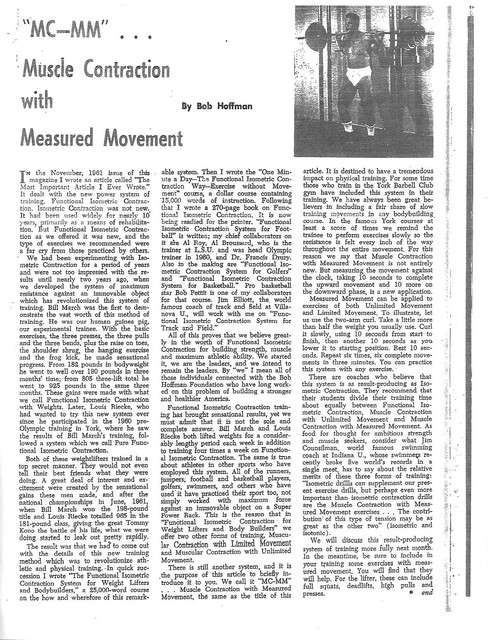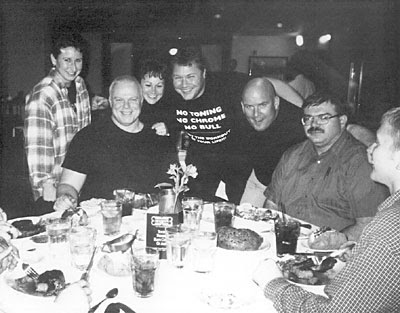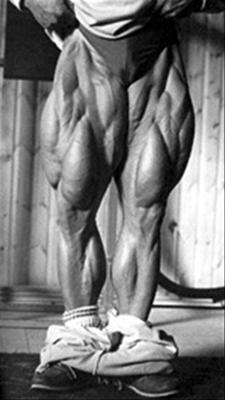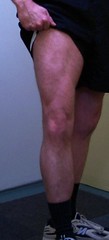
The above article titled Muscular Contraction with Measured Movement is from a March 1962 issue of Strength and Health magazine. The article was written by the late Bob Hoffman, founder of the infamous York Barbell Company. The men and women who made up the York company and the enthusiasts who followed their regimens were and still are considered among the “heart and soul” of modern body building and athletics.
In the article, slow repetition training is discussed as a powerfully productive method of building strength, muscle and athletic ability. And what is the MC MM repetition tempo? 10 seconds to lift, 10 seconds to lower using about half the weight one usually uses in their training. That’s pretty slow.
“For some time those who train at the York Barbell Club gym have included this system of training. We have always been great believers in including a fair share of slow movements in any body building course.”
It goes on to discuss how powerful a protocol MC MM is and how a world famous swimming coach considers it to be the best of all the strength and conditioning protocols. Take a look-see:

That’s a pretty powerful endorsement for slow rep training from a top athletic coach wouldn’t you say? And if he didn’t think it was so beneficial, why would he say it? That this was said 40+ years ago makes no difference. Many power athletes today still use and sing the praises of the training methods of the lifters of yesteryear.
There are many people today who say things like “If slow rep, HIT training was/is so good, how come no coach’s or athletes use it?” Well they did and they still do. If you’re one of the many people who question the efficacy of slow tempo training, let’s dispense with this sort of talk from now on, agreed? It worked then and it works now.
I bring this article to the surface to illuminate an issue that often arises when I hear people talk about slow rep, high intensity training. It seems that, regardless of their schooling, their experience, their kindly and friendly persona’s, many people disseminate misinformation about slow rep, HIT training. These same people are, interestingly enough, very careful when discussing other forms of exercise. But when it comes to slow rep, HIT training, they feel that it is perfectly fine to say whatever it is they wish to say about it – facts and history be damned. And that’s a shame.
I listened to Robb Wolf and his partner Greg Everett discuss Slow Burn training on his recent podcast. Before I say more about this, let me say that I like Robb Wolf’s work and having met him on one occasion, I like Robb as well. He’s a knowledgeable, fit as a fiddle dude who has much to contribute to the fitness arena. My knowledge of nutrition pales in comparison to his (or should I say paleos in comparison) and his book <a href="The Paleo Solution: The Original Human Diet is indeed worth reading. So let me say again, I like Robb, I think his work is very good, I’d enjoy having a beer with him (drat – we are both gluten intolerant – a glass of wine then) and have done my fair share of promoting him.
is indeed worth reading. So let me say again, I like Robb, I think his work is very good, I’d enjoy having a beer with him (drat – we are both gluten intolerant – a glass of wine then) and have done my fair share of promoting him.
Said yet another way so that none of you come away after reading this post thinking otherwise – I like Robb and respect his work.
After listening to their podcast, I realized that Robb and Greg Everett’s depiction of what Slow Burn is and what it can do for you is unfortunately fraught with several factual problems, a smidge or two of illogic and a dash of undeserved disdain.
Someone wrote in a question asking them about Slow Burn training. Greg reads the letter aloud to his listeners and as he reads it, associates Slow Burn with me by mentioning my name. At first Greg gets my name right but then immediately pretends as if he suddenly doesn’t know that I wrote the book at all. He says “This is the Fred Hahn or Frank Hahn or Gary Hahn or someone Hahn…” Wassup wit dat?
Now, why after getting my name right would Greg pretend not to know that Slow Burn was written by me when he obviously does know? Are we to believe that he had no idea I was the author of the book and just took a random guess at a name and, out of every name possible to choose from, just happened to choose the name Fred as his first guess?
Robb Wolf knows that The Slow Burn Fitness Revolution was written by me and my co-authors Drs. Mike and MaryDan Eades. So why didn’t Robb correct Greg by saying something to the effect of “Hey Greg man, it’s Fred Hahn and Drs. Eades who wrote the book?” Why not take the time to get our names right? I mean, it’s basic fact checking not to mention professional courtesy to your peers. Can you imagine how strange it would be if I blogged on Robb’s book and said something like “The Paleo Solution by Robb Wolf, or Greg Wolf or Dan Wolf or somebody Wolf…”
I’m just sayin’…and trying to illuminate in saying this how perfectly cool people somehow allow themselves to act oddly when discussing slow rep training. No hard feelings now.
Moving on…
At ~41:58 into the program, Greg immediately seems to poo-poo Slow Burn training. He states that the guy who wrote in to ask about Slow Burn was already using a protocol of training (using kettle bells and body weight exercise along with a paleo diet) to gain muscle and lose weight. He said that his current regimen was working well for him and, since it was working well for him, Greg chides him by saying why bother to do anything else then. “If it ain’t broke don’t fix it” Greg implies.
Well, the guy wrote in to ask specifically about Slow Burn training did he not? Maybe he wants to find something that might work even better than what he is currently doing. Why belittle his question by acting like the question is not even worth asking?
Greg then says (intentionally or not but ultimately making light of the guy’s question): “That’s the problem with the internet. There’s so much freaking information out there.”
Jesus wept. That’s the problem with the internet? That’s the entire point of the internet. And again, why make light of the man’s question – just answer it. And if you can’t answer it because you don’t know anything about it, skip it. Again, let me be clear here – had the guy wrote in asking about virtually any other type of training I will bet you dimes to doughnuts that Greg and Robb would not have said what they did. Has the guy asked about periodization training or Olympic lifting or cross fit training they would NOT have suggested that they guy should stick to what he was already doing. They more than likely would have given the guy a solid description of those types of training regimens.
But slow rep Slow Burn training? Why bother.
And I wonder what makes Greg think that Slow Burn is some weird and obscure internet exercise system that the guy found lurking deep within the bowels of cyberspace? It happens to be one of Random Houses best-selling fitness books with nearly 100,000 books in print that has been translated into three languages and a fourth on the way.
Prior to this part of the podcast and seconds after this statement, Robb says that one of the problems with any training program is that after a time you get used to it and need to change it. (Personally I don’t buy this idea at all.)
At 43:30 into the podcast he quotes the famous power lifter Louis Simmons as saying: “Everything works but nothing works forever.” Well if that’s the case, then why did Greg imply that the guy who wrote in asking about Slow Burn should stick to what he was already doing since it was working? Which is it gentlemen? And this is really funny on many fronts because how often do you hear these guys say “Ya gotta stick to the basics man – squat, bench and dead.” So nothing works forever BUT we should always stick to the basics.
To be fair, towards the end of the Slow Burn part of the podcast Robb does say that you should use a protocol that works until the bitter end. But why wait? Why run a protocol of training into the ground before trying something new?
My old Buick Rendezvous was a good car. It worked very well. It worked very well until the day I traded it in. No complaints really. But my new Honda Odyssey blows it away. Should I have waited until the Rendezvous was a wreck before I switched? Of course not. As soon as I realized that there was something else out there that I could drive and was that much better and safer, I grabbed it. It would have been a real hoot to hear the dealer say “Why do you want to drive a better car when the one your driving is good enough?”
Robb then states that he likes Slow Burn and calls it (and I) “super cool” (which is nice) and that the Slow Burn protocol is a way to “maintain some muscle mass and some strength.” Just maintain? It’s as if he thinks that this type of training cannot build significant strength and muscle mass. But they must know that it can. So why state it in this way? Why not be more positive about it? Why be so oddly reserved and aloof when talking about it? I’m not saying they should sing its praises mind you but why say that is will only “maintain” strength?
To me it seems that they are being needlessly cautious about promoting slow rep training so as not to seem as if they are actually promoting it for fear – OK not fear per se – but for caution that the “big dudes” out there who are into power and explosive lifting might take issue to their thumbs up to slow rep training. I’m guessing here because if you know anything about slow rep training, you know that it is not only a very grueling and intense form of exercise, but produces fantastic results.
And it is true that many hardcore power lifters and people of their ilk make fun of slow rep training. Most of these people have never once experienced this type of training in their lives. The few that have experienced it, no longer make fun of it. Big Drew Israel a.k.a “The Human Wall” comes to mind. (Big Drew is second from the left in the picture below. Drew is a great guy.)
Drew was one of the largest and strongest of Dr. Ken Leistner’s “students” back in the 90’s. After a series of injuries sustained from the kinds of training methods that are usually described as functional and power driven, Drew turned to slow rep training and found it to be not only extremely useful but made him stronger than ever and did not diminish his athletic ability. Quite the contrary.

Robb also stated in his podcast that my co-author Dr. Mike Eades had advocated fast twitch oriented, explosive type training in his book The Protein Power Life Plan and asked Dr. Eades why he took an about face from recommending this type of training. Robb said that Dr. Eades explained to him that he did so because he just doesn’t like working out and that Slow Burn preserves his muscle mass and keeps up his golf game.” But this is not exactly why Dr. Eades dispensed with his recommendation for explosive type training in favor of Slow Burn. He dispensed with it because after reading the scientific literature he realized that slow rep training was superior – just like the oldetime York strength enthusiasts experienced.
All due respect given, Robb is not correct in his implication that exercises causing fast or explosive movements are necessarily using fast the twitch muscle fibers.
Fast and slow twitch refer to the “fatiguability” of muscle fibers, not the speed with which they contract. Regardless of the movement speed, if a set of an exercise is taken to momentary muscular failure where no further concentric (lifting) work is possible all of the available fibers – slow to fast – are recruited. Even the world famous physiologist Vladimir Zatsiorsky states this in his book Science and Practice of Strength Training.
So just because you toss a medicine ball around quickly this does not mean that your fast twitch fibers are firing. For this to happen, the medicine ball would have to be so heavy that you couldn’t toss it fast if you tried or of you kept tossing it until you could barely lift it.
You do not need to train in a fast or in an explosive (potentially unsafe) manner in order to recruit the fast twitch fibers which are the fibers most responsible for increasing strength and muscle mass. You simply need to continue the contraction until total fatigue occurs using a weight load that renders failure in no more than about 120 seconds.
Towards the end of the podcast Greg inadvertently puts a few words in Robb’s mouth by stating that Slow Burn might indeed build some muscle mass and strength, but will contribute nothing to athleticism. This is a huge error and goes completely against reality. Let’s stop and think about this for just a sec. But before we do, let’s take another close up view of the MC MM article:

And if you recall, the champion swim coach quoted in the Hoffman article felt that MC MM was the superior method above all for improving athleticism. The past can teach us much.
So, what is “‘athleticism?” And what for that matter is an “athlete?” As I see it, an athlete is a human being that engages in athletics. Athleticism is the act of being athletic. Athleticism therefore requires the contraction of muscles so that the body moves through time and space. To suggest that making an athlete stronger and more muscular regardless of how one does it (either with slow reps or isometric contractions) will not contribute to enhanced athleticism is, IMHO, to not understand what athleticism is.
Then Greg says that if you like athleticism he can’t imagine being put through the “misery” of Slow Burn training. Well, Slow Burn training is designed to improve upon your existing strength and muscle mass so that you can go out in the world and do whatever it is you choose to do that you enjoy doing better. And yes, Slow Burn is intense. But any form of exercise that improves upon your existing state of physical conditioning is uncomfortable and challenging and may be looked at as miserable. Many if not most of my clients refer to Slow Burn as such – perhaps not as miserable, but rather as challenging and exhilarating. Many write in that is has changed their lives.
The fact is that you do not NEED to do all sorts of potentially dangerous types of exercises like Olympic lifting, plyometrics, or Cross Fit training in order to come away with a stronger, leaner and more powerful body. The notion that you do is a bunch of horse-hockey that certain people (not necessarily Robb and Greg mind you) who are addicted to exercising would have you believe. While these forms of exercise can absolutely be fun to engage in much in the same way that snow boarding over moguls can be great fun, don’t you believe for a second that they are necessary to perform in order to be “atheltic.” You need strong and enduring muscles to be athletic. And you don’t want to damage yourself in the process of becoming stronger to be more athletic. Capeesh?
The moral of this long-winded blog is, if you are going to write or talk about something you know nothing about, rather than making stuff up about it, just skip it. If you think you do know something about it, make sure you have your facts straight by doing a little homework. Praise your audience and answer their questions as fully and as responsibly as you can. Refrain from red herrings and other logical fallacies as best as possible. Give full credit where credit is due.
Doing it this way is better for everybody involved and brings us all closer together.
Happy spring!




























